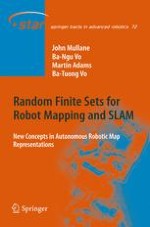The monograph written by John Mullane, Ba-Ngu Vo, Martin Adams and Ba-Tuong Vo is devoted to the field of autonomous robot systems, which have been receiving a great deal of attention by the research community in the latest few years. The contents are focused on the problem of representing the environment and its uncertainty in terms of feature based maps. Random Finite Sets are adopted as the fundamental tool to represent a map, and a general framework is proposed for feature management, data association and state estimation. The approaches are tested in a number of experiments on both ground based and marine based facilities.
